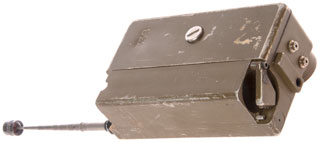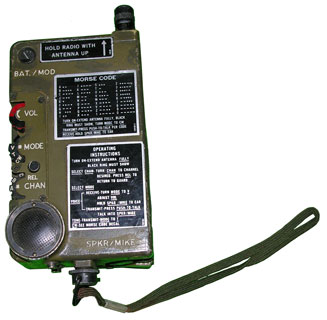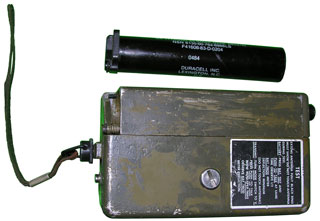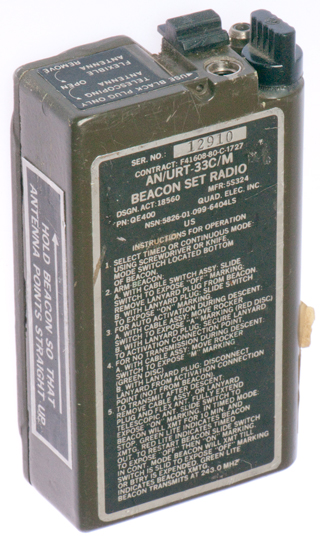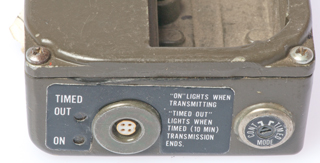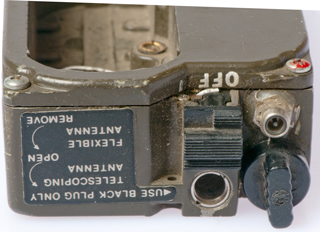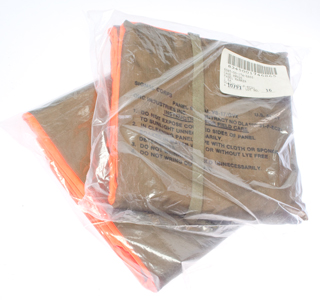AN/PRC-90 & AN/PRC-103, AN/PRC-106
These radios are part of the bail out kit that aircrew members carry. It is turned on by the user, not automatically like the URT-33.PRC-96 Navy Lifeboat Survival Radio
The improved PRC-90-2 survival transceiver is familiar to most military aviators as the rugged, hand-held survival radio that has saved the lives of thousands of downed pilots and crew members. It has voice and beacon capability on the military distress frequency of 243.0 with voice Tx and Rx only on 282.8 MHz. 282.2 MHz is used by the Civil Air Patrol for ground - air coms with military aircraft during SAR operations.The PRC-106 is a derivative of the PRC-90-2 and provides both beacon and voice Tx/Rx capability on the civil and military distress frequencies of 121.5 and 243.0 MHz, but does not have the 282.2 MHz channel.
The PRC-103 and PRC-195 are other derivatives of the PRC-90.
The AN/PRC-90 Legacy by Alan D. Tasker, WA1NYR - also has the PRC-106
Military Survival Transceivers - ACR PRC-90-2 and PRC-106 with table of specifications
PRC-90 Separate Web Page -
PRC-103 eBay photo -
PRC-112
This unit replaced the PRC-90. It is a synthesized radio that covers 225 to 400 MHz and has a transponder function to help rescuers locate the radio. My guess is that when the location mode is turned on the radio turns on and off at a rate depending on how far it is from the rescue aircraft giving the aircraft range to radio.
The civilian and military have gone to the 406 MHz digital rescue radios that are supported by the SARSAT system.
The PRC-112 transmits the digital signal at 406.028 MHz. (SARSAT Report 708-1)
Major components to the AN/AYD-1 Personnel Locator System (PLS).
The PRC-112 has two fixed channels assigned to 121.5 and 243 MHz that can be used in either beacon mode or AM voice mode.
- SARSAT system.
- The KY-913/PRC-112 program loader loads the
- PRC-112 with frequency of operation (225 to 300 MHz) and a personal ID number (actually the SARSAT data set).
- The AN/ARS-6(V) is the aircraft system that interoperates with the PRC-112 giving the pilot either bearing or bearing and distance to the survivor.
- TS-4360 Test Set
It too uses a specialized BA-5312/U 3.4 AH battery instead of commonly available batteries, but there is an official battery adapter being developed by the government.
There are a large number of variations on the PRC-112. The later ones have a built in GPS receiver to allow reporting position. The design constraints for the PRC-112 are different than for a civilian survival radio in that the PRC-112 probably will be used behind or near enemy lines.
I doubt that the AN/ARS-6(V) can be used with civilian 406 MHz beacons.
If the PRC-112 is sending a SARSAT compliant digirtal message then it can be picked up by an enemy receiver, seems like a problem.
patent 5726663 Survival radio interrogator March 10, 1998, Motorola, 342/419 ; 342/357.09; 342/386; 701/213 -Motorola - PRC-112 - was the origional contractor for the PRC-112 and General Dynamics has now taken over production.
General Dynamics Decision Systems - PRC-112B1 -
AN/PRC-112 COTS Battery for Navy Air Crews - after 9/11 the BA-5112/U NSN 6135-01-439-6229 was very hard to getSurvival radio on Space Shuttle - upgraded Motorola PRC-112
FAS - PRC-112 - Hook-112
PS Magazine - 3 item free upgrade -
Operation Allied Force (OAF) deployment order on 17 February 1999 to the completion of OAF in June 1999 - "VMAQ-2 aircrews were not issued the latest survival radios (PRC-112) prior to arriving in theater due to a DOD wide shortage."
Market Survey for the AN/PRC-112 Feb 2002
Ultra Life Batteries - BA-5312/U - Replaces the BA-5112/U
The CSEL will eventually replace the PRC-90, PRC-112, and the Hook 112 survival radios -- all of which are only capable of transmitting voice and in some cases data line of sight.
IFR Systems - RCTS-003 test set for survival radios
Indicator (Standard Embeddable Module) - voice crypto for the PRC-112
Cubic Defense Systems - AN/ARS-6(V) Data Summary - 225 - 300 MHz both passive homing (RPC-90) and active transponding with PRC-112 for range.
AF - Combat Survivor Evader Locator (CSEL) System - AN/PRQ-7 Hand Held Radio (HHR)
Pilot's widow files suit - not much of a case
Capt. Scott F. O'Grady used PRC-112 (rough plot of movie "Behind Enemy lines)
PRC-149
& URT-140
NSN 5826-01-466-0186
Beacons on 121.5, 243 and 406.025 MHz, voice on 121.5, 243 and 282.8 MHz and has a burilt in GPS position locating capability.
SAR radio for troops not forward deployed and recsue swimmers.
The URT-140 is the ejection seat beacon only version of the PRC-149.
Designed to run from a couple of "D" size 3.6V batteries. There have been a number of reports about battery venting, sparking, etc. that has resulted in the development of a very special battery just for this radio. Also there's a problem when the radio is carried loose in a bag where it can get turned on accidently. A lockout clip has been designed as an add on fix.
SARSAT Report 703-1 shows two Saft "D" cells LSH-20 - this is 3.6V Li-SOCl2 chemistry.
2013 Notice of Intent for AN/URT-140
ProPublica: Adrift: How the Marine Corps Failed Squadron 242 Dec. 30, 2019 - Adrift video 12:11, Faulty Equipment, Lapsed Training, Repeated Warnings: How a Preventable Disaster Killed Six Marines -
RT-159A/URC-4
Works on 121.5 mhz VHF and 243.0 mhz UHF. Uses 1 miniature and 5 sub-miniature tubes. Dual antennas can be used as a single whip or a double horizontal. eBay Photo - Manual is TM 11-510 November 1956. Korean conflict
Carried on the Viet Nam era Patrol Craft Fast (PCF).
Movie credits: Ice Station Zebra, The Bridges at Toko-Ri, Bombers B-52, Flight from Ashiya, Battle Taxi
ASR-100
121.5 VHF & 243 UHF, 1965
Kel Corp. ASR-100: Replacement for the URC-4; AA batteries, destroyed with salt water exposure; Use URC-10 in seat packs, "The solution for the deployment appears to be the use of the URC-4. It is felt that this unit will be satisfactory if it is aligned on a selected frequency and then sealed."
ASR-100A monobloc battery; must withstand decompression to 100,000 feet,
URC-10 (see RT-10
below)
eBay Photos - A, B, C, D -
TM 11-5820-640-15.pdf
RT-285 A/URC-11
Radio R/T RT-285 A/URC-11 Survival Radio, Cont. No. AF33 (604) 26183 Philharmonic Radio & Tel. Corp. Tuned to 243 MC. Has 4 Raytheon sub miniature tubes some are JRP 6397's and CK 6526's.+ Raytheon (2), 2N467 transistors. Battery is external via connector wire. Approx. 20" telescoping ant. eBay Photo -
URC-14
Description said tubes and 121.5 MHz. eBay photo
URC-64
U.S. Military Portable Radios by Alan D. Tasker, WA1NYR - has URC-64 informationCovers the 225 to 285 MHz range using crystals.
"The Air Force developed the URC-64 four channel device. The Army opted instead for the URC-68, a four channel two band (VHF/UHF) radio for helicopters that allowed downed airmen to communicate directly with ground troops as well as aircraft. Both of these were ultimately replaced by the Navy developed and improved PRC-90-1 and then -2 two channel unit (243 and 282.8 MHz), the first tri-service SAR radio." eBay Photo -Rescue of Bat 21 Bravo (Wiki) - "The URC-64 survival radio was his most important survival item."
Books:
Bat-21 (1985) by William C. Anderson
The Rescue of Bat 21 (1999) by Darrel D. Whitcomb
PJs in Vietnam: The Story of Airrescue in Vietnam As Seen Through the Eyes of Pararescumen, SMSgt Robert L. LaPointe, USAF, Retired - photo caption on back dust jacket "It includes a survival vest, two URC-64 survival radios, GAU-5 rifle, hand grenades, M-79 grenade launcher, .45 pistol, and three quarts of water."
Movies:
BAT*21 - 1988 (IMDB)
Description
Antenna: 6 section 21-3/4" (0.55m) 1/4 wave at 136 MHz
Battery: BA-1113, aprox. 1" dia x 4-3/4"
Case: 6-1/4" hi x 3-3/16" wide x 2-1/8" deep (27-5/8" with antenna extended)
Internal crystals (Fig 3):
Chan
Freq Mhz
Wire
Xtal
2*Xta/IFl
3*Xtal/IF
4*Xtal/IF
A
243.0 Brn
79.000 158/85
237/6
316.0/73
B
247.3 Red
80.075 160.15/87.15
240.225/7.075
320.3/73
C
248.2 Org
80.300 160.6/87.6
240.9/7.3
321.2/73
D
282.8 Yel
88.950 177.9/104.7
266.85/15.75
355.8/73
Frequency Analysis
In the above table I tried 2x, 3x and 4x the Crystal frequency, and 4x did work with an IF of 73 MHz. The x2 and x3 multipliers did not work (IF freq different for each channel), so I've used strike-through to mark them as non functional.
RF = 4 * Crystal - 73.0 MHz
Controls & Indicators
Top: Antenna (Fully extend to turn on) & Battery Test button
Front: Modulation analog meter ( also battery meter w/PPT), Volume, Mode (only Tone and Voice work, CW locked out), CHAN A, B, C, or D (the RELease button needs to be pressed to change channels. If the RELease button is pressed and channel B, C or D was already selected the channel knob returns to channel A), Speaker-Microphone
Bottom: two male snap terminals for earphone (with magnet to silence speaker), 1/4-20 threaded socket (attaches to camera tripod), swing out battery holder.
Left Side: Push-To-Talk button
Photos
Fig 1
Fig 2
Fig 3
Fig 1
Courtesy of : www.FlightHelmet.com
Fig 2
Courtesy of : www.FlightHelmet.com
Fig 3
Courtesy of : www.FlightHelmet.com
BA-1113
NSN: 6135-00-782-6988LS
0484
Duracell Inc.
Lexington N.C.
U.S.
URC-68
Radio Set, Rescue, Army, 38-42 and 230-250MHz, 4 channel, xtal control
Normally turned on by the survivor, but optional kit to allows automatic operation when a lanyard is pulled, like in an ejection seat.
URT-33D/M Beacon Radio set (Ejection Seat)
Maybe featured in the movie "Behind Enemy Lines"?
Featured in the book "The Rescue of Alpha Foxtrot 586" by Andrew C.A. Jampoler (Navy Institute Press).
MIL-B-38401A 16 Feb 1965 discontinued 7 July 1992
For use with AN/ARA-50 or AN/ARC-34 aircraft receivers.
The rescue beacon will jam the frequency (121.5 or 243 MHz) so it's not usable for other purposes. Note the PRC-90 has an alternate channel for voice communications so can be used even if 243 is active with a beacon.
Antenna
There are two possible antennas. The built-in telescoping antenna or the external flexable antenna. Only one antenna can be used at a time.The flexible antenna is deployed in ejection seats along with a lanyard that turns on the radio when the seat ejects.
Versions
URT-33URT-33A
URT-33B-1
AN/URT-33C - w/o magents.
AN/URT-33C/M, 5826-01-099-6404 - A Magnet p/n A1-17-0672 added to actuation plug p/n A1-18-0921 forming automatic activation plug assembly p/n A3-06-0802 and a magnet p/n A1-17-0670 added to manual switch button p/n A1-18-0920 forming switch and magnet assembly p/n A3-06-0785.
Battery
BA-1516/U Mercury.NSN: 6135-01-50-3193LS Mercury for URT-33A
NSN: 6135-01-009-9135LS Mercury for URT-33A
NSN: 6135-01-478-3935
BT-70129 AnMn (Alkaline)
BT-70529 LiMnO2
NSN: 6135-01-050-3193 Alkaline, Eveready
Test Set
URT-33 Photos
These radios are built into the ejection seat survival pack. They automatically are activated when the seat ejects.
LCDR Castle Rescue in Laos by Nail, Sandy & Pedro 28 Dec., 1970- "The URT-33 is presently not connected to the aircraft because the kits required for the installation are not available, but VA-L5 will not connect them up automatically anymore. Since we feel that the VC have a sufficient number of radios that they can use to home on the beacon. Additionally the beacon virtually eliminates use of 243.0 until it is shut off, and if evasion is immediate the URT-33 might not be deactivated, and this could easily reduce or eliminate the possibility of radio contact." eBay Photo - URT-33B eBay Photo -Ejection Seats - PRC-90-2 & URT-33 -
CBD ad - The beacon is a first alert device that activates upon separation from a disabled aircraft, and transmits a swept tone signal at 243 MHz. Approximate dimensions are 4.8 X 2.5 X 1.2 inches. Opportunities for improved performance include: ability to transmit on 121.5 MHz (civil emergency), 243 MHz (military emergency), 245 MHz (training), and 406.025 MHz (COMPAS/SARSAT); ability to operate normally and unassisted during parachute descent and after touching down on land or water; features to impair an adversary's ability mimic its signal. Beacons should be reparable by a commercial source, compatible with existing means of activation (magnetic plug assembly or remote cable and switch assembly), and interface with existing parachute harnesses, survival vests, and survival kits
URT-44 Over-the-Horizon COSPAS-SARSAT Personnel Locator Beacon
Replacement for the URT-33.
ACR/RT-10 URC-10
243 MHz with a battery that has a flange and slides into a slot.
eBay photo Front, Back -


